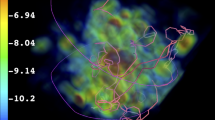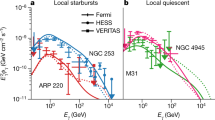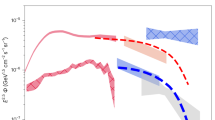Abstract
IF the dark matter in our Galaxy is made up of weakly interacting massive particles (WIMPs) with masses of the order of several GeV (for example, photinos or Higgsinos), γ-rays produced by their annihilation would in principle be observable1,2. But the expected flux3 from a smoothly distributed dark matter halo4,5 is much smaller than the observed diffuse background6, and although narrow lines might be produced, their intensity would be much too low to see with the Gamma Ray Observatory (GRO)3,7. A complementary approach is to consider unique spatial signatures. Numerical simulations of galaxy formation8 show that even in the central bulge of the Galaxy, the mean density of the dark matter could be equal to that of the stars. If this were so, GRO could see the Galactic Centre as a source of annihilating dark matter1,3. Other lumps formed as part of the hierarchical formation of the Galaxy could also produce sources that would be recognized by the shape of their continuum spectrum2,3 and a line feature in sufficiently bright sources3,7. Even Geminga9,10, the second strongest source of γ-rays at energies greater than 50 MeV, could be annihilating dark matter.
This is a preview of subscription content, access via your institution
Access options
Subscribe to this journal
Receive 51 print issues and online access
$199.00 per year
only $3.90 per issue
Buy this article
- Purchase on Springer Link
- Instant access to full article PDF
Prices may be subject to local taxes which are calculated during checkout
Similar content being viewed by others
References
Silk, J. & Bloemen, H. Astrophys. J. 313, L47–L50 (1987).
Stecker, F. Phys. Lett. B201, 529–532 (1988).
Stecker, F. W. & Tylka, A. J. Astrophys. J. 343, 169–176 (1989).
Caldwell, J. R. & Ostriker, J. P. Astrophys. J. 251, 61–87 (1981).
Kuijken, K. & Gilmore, G. Mon. Not. R. astr. Soc. 239, 571–603 (1989).
Fichtel, B. C., Simpson, G. & Thompson, D. Astrophys. J. 222, 833–849 (1977).
Bouquet, A., Salati, P. & Silk, J. Phys. Rev. D40, 3168–3186 (1989).
Carlberg, R. G., Lake, G. & Norman, C. A. Astrophys. J. 300, L1–L4 (1986).
Thompson, D. J., Fichtel, C. E., Hartman, R. C., Kniffen, D. A. & Lamb, R. C. Astrophys. J. 213, 252–268 (1977).
Bignami, G. F. in Cosmic Radiation in Contemporary Astrophysics (ed. Shapiro M. M.) 175–192 (Reidel, Dordecht, 1986).
Lake, G. Astrophys. J. (in the press).
Peebles, P. J. E. Astrophys J. (in the press).
Braunschweig, W. et al. Z. Phys. C45, 193–208 (1989).
Aguilar, L. & White, S. D. M. Astrophys. J. 307, 97–109 (1986).
Gott, J. R. A. Rev. Astr. Astrophys. 15, 235–66 (1977).
Carr, B. J. & Lacey, C. G. Astrophys. J. 316, 23–35 (1987).
Ostriker, J. P., Spitzer, L. & Chevalier, R. A. Astrophys. J. 176, L51–L56 (1972).
Hermsen, W. et al. Nature 269, 494–495 (1977).
Aaronson, M. & Olszewski, E. in IAU Symp. 177 Dark Matter in the Universe (eds Kormendy, J. & Knapp, J.) 153–165 (Reidel, Dordecht, 1987).
Sommer-Larsen, J. & Christensen, P. R. Mon. Not. R. astr. Soc. 225, 499–299 (1988).
Doinidis, S. P. & Beers, T. C. Astrophys. J. 340, L57–L60 (1989).
Peebles, P. J. E. Astrophys. J. 277, 470–477 (1985).
Lake, G. Astr. J. 98, 1554–1556 (1989).
Bahcall, J. N. Astrophys. J. 287, 926–944 (1985).
Bignami, G. F., Caraveo, P. A. & Lamb, R. C. Astrophys. J. 272, L9–L13 (1983).
Halpern, J. & Tytler, D. Astrophys. J. 330, 201–217 (1988).
Nulsen, P. & Fabian, A. Nature 312, 48–50 (1988).
Quinn, P. & Goodman, J. Astrophys. J. 309, 472–484 (1986).
Caillault, J-P. & Helfand, D. Astrophys. J. 289, 279–299 (1985).
Author information
Authors and Affiliations
Rights and permissions
About this article
Cite this article
Lake, G. Detectability of γ-rays from clumps of dark matter. Nature 346, 39–40 (1990). https://doi.org/10.1038/346039a0
Received:
Accepted:
Issue Date:
DOI: https://doi.org/10.1038/346039a0
This article is cited by
Comments
By submitting a comment you agree to abide by our Terms and Community Guidelines. If you find something abusive or that does not comply with our terms or guidelines please flag it as inappropriate.



